中考英语感叹句和反义疑问句
通用版2019中考英语二轮复习感叹句和反义疑问句讲义
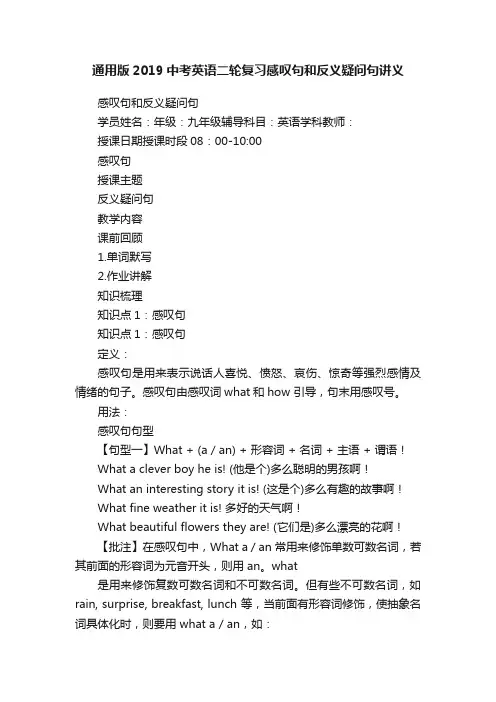
通用版2019中考英语二轮复习感叹句和反义疑问句讲义感叹句和反义疑问句学员姓名:年级:九年级辅导科目:英语学科教师:授课日期授课时段08:00-10:00感叹句授课主题反义疑问句教学内容课前回顾1.单词默写2.作业讲解知识梳理知识点1:感叹句知识点1:感叹句定义:感叹句是用来表示说话人喜悦、愤怒、哀伤、惊奇等强烈感情及情绪的句子。
感叹句由感叹词what和how 引导,句末用感叹号。
用法:感叹句句型【句型一】What + (a / an) + 形容词 + 名词 + 主语 + 谓语!What a clever boy he is! (他是个)多么聪明的男孩啊!What an interesting story it is! (这是个)多么有趣的故事啊!What fine weather it is! 多好的天气啊!What beautiful flowers they are! (它们是)多么漂亮的花啊!【批注】在感叹句中,What a / an 常用来修饰单数可数名词,若其前面的形容词为元音开头,则用 an。
what是用来修饰复数可数名词和不可数名词。
但有些不可数名词,如rain, surprise, breakfast, lunch 等,当前面有形容词修饰,使抽象名词具体化时,则要用 what a / an,如:What a heavy rain it is! 多大的一场雨啊!What a great surprise it is! 这多么令人惊奇啊!What a rich breakfast it is! 多么丰盛的一顿早餐啊!【句型二】How + 形容词 / 副词 + 主语 + 谓语!How well you look! 你气色真好!How kind you are! 你心肠真好!How beautifully you sing! 你唱得真好听!Strawberries! How nice! 草莓! 多好呀!How clever the boy is! 这个男孩多么聪明啊!How fast he runs! 他跑得多么快啊!注意(1)要修饰名词的形容词不能是表数量的many, much, little,few,遇此情况要用how,即使它们后面跟有名词:How many books he has!他的书真多!How much money he gave her!他给了她好多钱呀!How little money I have!我的钱多么少呀!How few friends he has!他的朋友真少!比较:What a little box it is!多小巧的盒子呀!(该little不表示数量)(2)有时句中的主语和谓语可以省略:How fast!多快呀!How nice!多好呀!How beautiful!多美呀!How nice of you to come!你来了真好!(3)常见的不可数名词有news, work, weather, homework, information, advice, experience经验,fun趣事,progress;但有些不可数名词前面有形容词修饰,使抽象名词具体化,则在形容词前加a/an,如rain, surprise, breakfast, lunch…例如:What a great surprise it is!What a heavy rain it is!感叹句巧解法一找·二断·三辨·四确定:“一找”即先找出句中的主语。
反意疑问句和感叹句
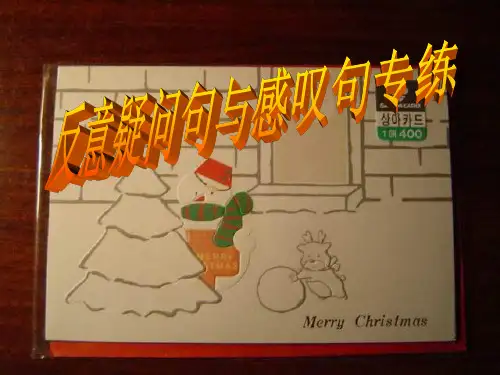
11. There were few students in the room ,_w_e_r_e__th__er_e___? 12. It is a little late ,___is_n_’_t_i_t___? 13. There will be no rain tomorrow ,_w_i_ll__th_e_r_e___? 14. My father never went to Xi’an ,__d_i_d__h_e____? 15. Nothing can stop him learning English ,__c_a_n__it____? 16. Something is wrong with your computer ,__is_n_’_t_i_t__? 17. Everyone is here ,__i_s_n_’_t _h_e___? 18. Don’t be late for class ,___w_i_ll__y_o_u__? 19. Let’s go to the cinema ,__s_h_a_l_l _w__e__? 20. Let us go out for a walk ,__w__il_l__y_o_u__?
_H__o_w__ time flies!
1.It is a long story. _H__ow__l_on_g__th_e_s_t_o_ry__is_______! _W_h_a_t_a_l_o_n_g_s_to_r_y_i_t _is_______! 2.This book is interesting. _H__ow__i_n_te_r_es_t_in_g_t_h_is_b_o_o_k_i_s__! W__h_a_t _a_n_in_t_e_re_s_ti_n_g_b_o_o_k_i_t _is__! 3.They are clever students. _H__ow__c_le_v_e_r_th_e__st_u_d_e_nt_s_a_r_e__! _W_h_a_t_c_le_v_e_r_s_tu_d_e_n_ts_t_h_e_y_a_r_e_! 4.It is warm today. __H_o_w__w_a_rm__i_t_is_t_o_d_a_y______! _W_h_a_t_a_w__a_rm__d_a_y_i_t_is_t_o_d_a_y__! 5.Jim runs fast.
感叹句和反义疑问句
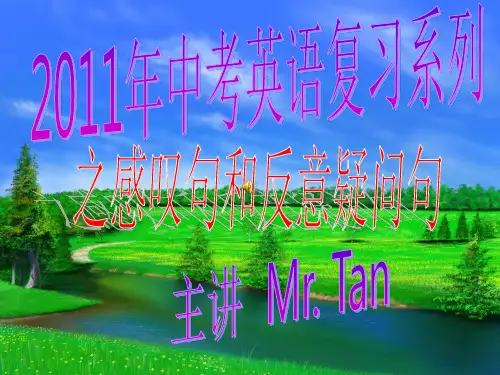
二、陈述句变为感叹句的方法
把一个陈述句变为感叹句时,常使用“一分 二加三换位四去掉”的方法。具体步骤为: 第一步:“一分”,即在谓语动词后面划一 双竖线,使句子分为两部分。如: He is ‖ a very honest boy.他是一个诚实的 孩子。 Li Lei works‖ very hard.李雷学习很刻苦。
4. My farther always works very hard . How hard my father works!
5. Sally has a sweet voice .
What a sweet voice Sally has!
课堂检测: 一、用How , What (a / an) 填空 1. ________ delicious food it is ! What 2. ________interesting film! What an 3. _________bad weather ! What What a 4. _________good day ! 5. How ________tall the boy is ! What 6. _________good news it is ! 7. What _________beautiful clothes they are ! What a 8. _________ nice teacher he is ! 9. How _________nice Tom is ! What 10._________ hard work ! What a 11. _________ hard job !
反意疑问句:由陈述句+简短问句构成。 简短问句由助动词 / be动词 / 情态动词 + 人称 代词构成。主要考点: 1、前肯后否,前否后肯的原则。即当陈述句为 肯定句时,简短问句为否定形式。当陈述句为 否定句时,简短问句为肯定形式。 2、句中含有no , never , hardly , few , little , nothing , nobody , seldom 等否定意义的词 时,后面用肯定形式。 如:There is little water in the bottle , is there? He can hardly speak English , can he ? 3、简短问句部分的主语应用人称代词。
中考英语反义疑问句、感叹句讲解及习题
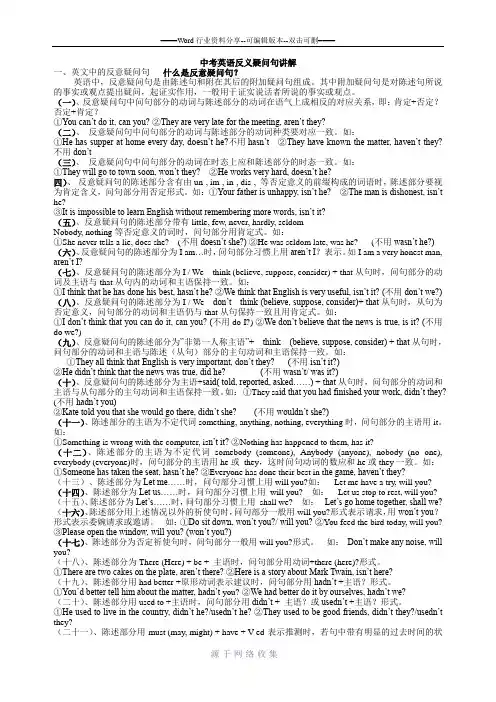
中考英语反义疑问句讲解一、英文中的反意疑问句什么是反意疑问句?英语中,反意疑问句是由陈述句和附在其后的附加疑问句组成。
其中附加疑问句是对陈述句所说的事实或观点提出疑问,起证实作用,一般用于证实说话者所说的事实或观点。
(一)、反意疑问句中问句部分的动词与陈述部分的动词在语气上成相反的对应关系,即:肯定+否定?否定+肯定?①You can’t do it, can you? ②They are very late for the meeting, aren’t they?(二)、反意疑问句中问句部分的动词与陈述部分的动词种类要对应一致。
如:①He has supper at home every day, doesn’t he?不用hasn’t②They have known the matter, haven’t they?不用don’t(三)、反意疑问句中问句部分的动词在时态上应和陈述部分的时态一致。
如:①They will go to town soon, won’t they? ②He works very hard, doesn’t he?四)、反意疑问句的陈述部分含有由un-, im-, in-, dis-, 等否定意义的前缀构成的词语时,陈述部分要视为肯定含义,问句部分用否定形式。
如:①Your father is unhappy, isn’t he? ②The man is dishonest, isn’t he?③It is impossible to learn English without remembering more words, isn’t it?(五)、反意疑问句的陈述部分带有little, few, never, hardly, seldomNobody, nothing等否定意义的词时,问句部分用肯定式。
如:①She never tells a lie, does she? (不用doesn’t she?)②He was seldom late, was he? (不用wasn’t he?) (六)、反意疑问句的陈述部分为I am…时,问句部分习惯上用aren’t I?表示。
反义疑问句与感叹句
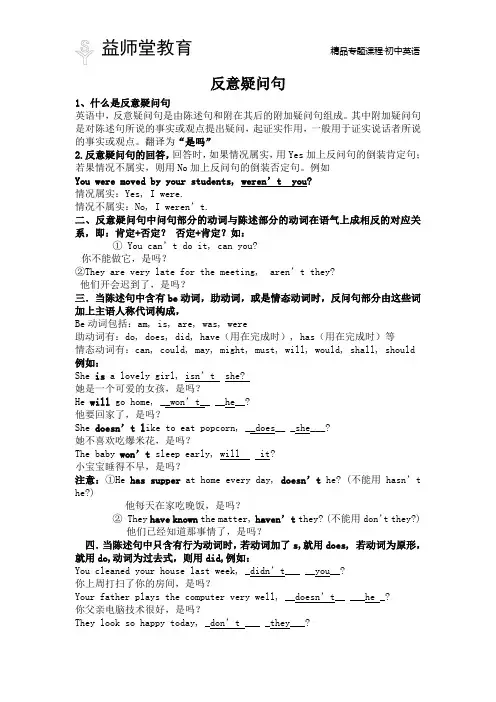
反意疑问句1、什么是反意疑问句英语中,反意疑问句是由陈述句和附在其后的附加疑问句组成。
其中附加疑问句是对陈述句所说的事实或观点提出疑问,起证实作用,一般用于证实说话者所说的事实或观点。
翻译为“是吗”2.反意疑问句的回答,回答时,如果情况属实,用Yes加上反问句的倒装肯定句;若果情况不属实,则用No加上反问句的倒装否定句。
例如You were moved by your students, weren’t you?情况属实:Yes, I were.情况不属实:No, I weren’t.二、反意疑问句中问句部分的动词与陈述部分的动词在语气上成相反的对应关系,即:肯定+否定?否定+肯定?如:①You can’t do it, can you?你不能做它,是吗?②They are very late for the meeting, aren’t they?他们开会迟到了,是吗?三.当陈述句中含有be动词,助动词,或是情态动词时,反问句部分由这些词加上主语人称代词构成,Be动词包括:am, is, are, was, were助动词有:do, does, did, have(用在完成时), has(用在完成时)等情态动词有:can, could, may, might, must, will, would, shall, should 例如:She is a lovely girl, isn’t she?她是一个可爱的女孩,是吗?He will go home, __won’t__ __he__?他要回家了,是吗?She doesn’t l ike to eat popcorn, __does__ _she___?她不喜欢吃爆米花,是吗?The baby won’t sleep early, will it?小宝宝睡得不早,是吗?注意:①He has supper at home every day,doesn’t he? (不能用hasn’t he?)他每天在家吃晚饭,是吗?②They have known the matter, haven’t they? (不能用don’t they?)他们已经知道那事情了,是吗?四.当陈述句中只含有行为动词时,若动词加了s,就用does, 若动词为原形,就用do,动词为过去式,则用did,例如:You cleaned your house last week, _didn’t___ __you__?你上周打扫了你的房间,是吗?Your father plays the computer very well, __doesn’t__ ___he _?你父亲电脑技术很好,是吗?They look so happy today, _don’t ___ _they___?你今天看起来很高兴,是吗?五.反意疑问句的陈述部分带有little, few, never, hardly, seldom,nobody, nothing, barely, scarcely等否定意义的词时,问句部分用肯定式。
中考英语总复习-反义疑问句和感叹句

4、陈述部分是祈使句时,用will \would you或won’t you 但祈使句为Let’s后用 shall we; Let us 后用will you Open the door, will you? 5、陈述部分是感叹句,后用be的一般现在时的否定。 What a kind girl,isn’t she? 6、陈述部分的主语是从句、不定式、动词ing或复合不定代 词时,后用it。 Nothing is wrong, is it? What you want is time,isn’t it?
反义疑问句
前一句陈述事实,后面一句提出相反的反问 句 1、反义疑问句必须和前一句意思相反,即前 肯后否、前否后肯。 2、为避免重复,反义疑问句是一个缩略的句 子。 3、反义疑问句中的主语或宾语必须用代词。 Mary is your sister,isn’t she?
注意事项
1、陈述部分有含否定意义的词,如seldom,little,never等时, 看做否定,后用肯定。 He seldom smokes,does he? 但:如果否定来自词的前缀或后缀时,仍看做肯定,后用否定 He dislike the book,doesn‘t he? 2、陈述部分是there be,疑问部分用be的适当形式+there There was a girl yesterday,wasn’t there? 3、陈述部分有情态动词must + be (推测)后用be 的否定形式 Mary must be your sister,isn’t she? 但:must表必须时,后用needn’t。 I must go, needn’t I? mustn‘t 表禁止时,后用must You mustn’t smoke in the hospital, must you?
初中英语语法复习 18种特殊的反意疑问句
江西省吉安县凤凰中学初中英语语法复习 18种特殊的反意疑问句2.感叹句。
感叹句后加反意疑问句时,其反意疑问句需用be的一般现在时态的否定形式。
例如:What fine weather, isn't it? 多好的天气啊,是吧?3. 当陈述部分谓语动词是need, dare, used to,且这些词被用作实义动词时,其反意疑问句需用do的适当形式。
例如:He needs help, doesn't he?他需要帮助,是吗?4.陈述部分主、谓语是I am...时,反意疑问句用aren't I 或ain't I ,而不是am not I (可用am I not)。
例如:I'm working now, ain't I? 我在工作,是吗?5.陈述部分的主语是everything, nothing, anything或something 时,反意疑问句的主语应用代词it。
例如:Something is wrong with my radio, isn't it? 我的收音机出毛病了,是吧?6.陈述部分的主语是 everybody, everyone, a nybody, anyone, somebody, someone, nobody, no one, none, neither 时, 其反意疑问句的主语需用复数代词they。
例如:Everyone is here, aren't they? 大家都到了,是吗?No one knows about it, do they? 没有人知道这件事,对吗?7.陈述部分的主语是指示代词this或that时,反意疑问句的主语用it,当陈述部分的主语是指示代词these或those时,其反意疑问句的主语用they。
例如:This is a plane, isn't it? 这是一架飞机,是吗?These are grapes,aren't they? 这些是葡萄,是吗?8.陈述部分的主语是不定代词one时,反意疑问句的主语可以用one,也可用you(美式英语用he)。
语法专题 04 感叹句、反义疑问句、祈使句-2023年江苏中考英语二轮复习语法专题讲解与题型强化训练
语法专题04感叹句、反义疑问句、祈使句☞【考点介绍】☞【应试技巧】一、感叹句①中考中常考的一些不可数名词有以下这些:news,information,advice,weather,fun,music,traffic,work,food,knowledge,furniture,progress等。
②有些不可数名词,如果前面有形容词修饰,要将这些抽象名词具体化,在这些不可数名词前加不定冠词a/an.如:What a great time we had last week!What a heavy rain!二、反义疑问句考点一:反意疑问句的类型1. 陈述句部分带有never, few, little, nothing, nobody, no, none, neither, seldom, hardly, too...to...等否含有定意义的词时,此陈述句为否定句,其附加疑问句要用肯定形式。
She never tells a lie, does she?He is too young to go to school, is he?注意:陈述句部分带有具否定含义的前缀时,该句不可被认为是否定句,依然是肯定句,疑问句部分仍然用否定形式。
如:He looks unhappy today, doesn’t he?2. 陈述句部分为There be句型时,疑问句部分用be there 形式。
如:There is a tree in front of our classroom, isn’t there?3. 陈述句部分的主语是指事或物的不定代词如:something, anything, nothing, everything时,附加疑问句部分的主语用it。
如:Something is wrong with the computer, isn’t it?4.陈述句部分的主语是指人的不定代词如:somebody (someone), anybody (anyone), nobody (no one), everybody (everyone)时,附加疑问句部分的主语用he或they,这时问句动词的数应和he或they一致。
最新中考感叹句+反义疑问句句教学案
中考感叹句+反义疑问句句教学案感叹句☆ 定义感叹句是一种表示强烈感情的句式,能表达喜悦、愤怒、悲哀、惊奇、厌恶和赞赏的思想感情。
通常由或来引导。
☆转换由what 引导的感叹句与由how 引导的感叹句有时可以转换,但how 引导的感叹句中,要放在前。
例子:What a beautiful girl she is! =How she is!反意疑问句☆ 定义:反意疑问句是指当提问的人对前面所叙述的事实不敢肯定,而需要向对方加以证实时所提出的问句。
★ 结构:前陈后疑(简略疑问句结构:)原则:否定词包括:★ 特殊情况:(4) 回答:实话实说练习:Fan Bingbing is beautiful, isn’t she? She is an honest girl, isn’t she?She never tells lies.Tom is never late for school, isn’t he?This morning Tom was late again.一、英语阅读理解专项练习试卷1.阅读理解In order to tell you what I believe, I must bring up something from my personal history.The turning point of my life was my decision to give up my business job and study music. My parents, although sharing my love of music, didn't think it was a good choice that I took up music as a job. Considering my family background, this was understandable. My grandfather had taught music for nearly forty years at Spring Hill College in Mobile, and though he was much loved by his students, he didn't earn(挣钱) enough to provide for his large family. As a result of this example in the family, my parents strongly asked me to go to the college instead of a conservatory(音乐学院) of music although I loved my violin and spent most of my spare time practicing.Before my graduation from Columbia, the family ran into some money problems and I felt it was my duty to leave college and take a job. That was why I took a business job, which I always think of as the wasted years. I went into it for money, for being able to help the family. Money is all I go out of it. It was not enough. I felt that life was passing me by.My wish was to save enough to quit(退出)and then go to Europe to study music. I continued to make money, and finally, bit by bit, I earned enough to make myself able to go abroad. The family got out of the trouble and ▲ . I felt like a free man and sailed for Europe. I stayed for four years, worked harder than I had ever dreamed of working and enjoyed every minute of it."Enjoyed" is too soft a word. I walked on air. I really lived. When I broke away from business, it was against the advice of all my friends and family, but if I had stayed in business, I do not believe I would have made a success of living.(1)The writer presented his grandpa's example in order to .A. show how much his grandpa was loved by his studentsB. tell to be a musician wasn't a good choice for the writerC. explain why his parents disagreed him to take up music as a jobD. thank his parents' support for studying in the conservatory of music(2)How did the writer feel when he was taking his business job?A. Successful.B. Shameful.C. Hopeful.D. Painful.(3)Which of the following can best fill in the blank in Paragraph 4?A. my point was that business was not for me.B. my help was no longer necessary.C. I earned so much to support my family.D. I got up early to practice the violin.(4)From the underlined sentence "I walked on air", it can be inferred that the writer .A. couldn't find his place in a new environmentB. couldn't make a success of livingC. felt free because he was doing what he lovedD. felt pity for beginning a new life【答案】(1)C(2)D(3)B(4)C【解析】【分析】文章大意:文章通过爷爷的故事告诉我们为啥他的父母反对他从事音乐工作,到后来真正的做了自己喜欢做的事。
感叹句和反义疑问句
感叹句和反义疑问句:
一、感叹句:
1.作用:感叹句用于表达喜、怒、哀、惧等强烈的感情。
2.类别:主要有由感叹词how或what引导的两种。
另外,陈述句、祈使句等,甚至
一个单词或一个短语都可以通过改变语调或在句尾加感叹号!而表示强烈的感情,从而成为感叹句。
如下表:
1.作用:表示怀疑或没有把握,需要对方用Yes或No回答。
但有时是为了加强陈述
句的语气,并不要求对方回答。
2.反义疑问句是放在陈述句后面的一个简短问句,也叫“附加疑问句”,通常用逗号
与前面的句子隔开。
复合“前肯后否,前否后肯”的原则。
3.反义疑问句部分由“系动词be、助动词或情态动词+主语”构成
注意:有些反义疑问句,前面的句子形式上是肯定句,但是因为有never, hardly, no ,
few, little 等表示否定意义的词时,附加疑问部分的动词必须是肯定形式;但是,如
果陈述部分的否定词带有否定前缀的词如unsuccessful, impossible时,附加疑问部
分仍然用否定形式。
如:He looks unhappy, doesn’t he?
Maria has few friends in China, _______?
A.has she
B. doesn’t she
C. does she。
- 1、下载文档前请自行甄别文档内容的完整性,平台不提供额外的编辑、内容补充、找答案等附加服务。
- 2、"仅部分预览"的文档,不可在线预览部分如存在完整性等问题,可反馈申请退款(可完整预览的文档不适用该条件!)。
- 3、如文档侵犯您的权益,请联系客服反馈,我们会尽快为您处理(人工客服工作时间:9:00-18:30)。
中考英语感叹句和反义疑问句
一、结构:
What/ How +被感叹的部分+ 主语+ 谓语!
What beautiful flowers they are !
二、变法:
一断,二加,三调位。
一断表示在谓语动词的后面断开,二加表示在断开的两部分中间加what 或how ,三调位表示前后两部分对调位置。
They had a good time yesterday .
一断:They had / a good time yesterday .
二加:They had(what)a good time yesterday .
三调位:What a good time they had yesterday.
三、what引导的感叹句:
1.what + a / an +adj + 单数名词(+主语+ 谓语)!
_______ a clever boy he is !
2.what + adj + 复数名词(+主语+ 谓语)!
_______ heavy boxes they are !
3.what + adj + 不可数名词(+主语+ 谓语)!
_______ bad weather !
四、how引导的感叹句:
1.How + adj / adv + 主语+ 谓语!
_________ hard they are working !
2.How + adj + a / an + 单数名词(+主语+ 谓语)!
How tall a boy he is !
3.How + adj / adv + the + 名词+ 谓语!
________ heavily the rain is falling!
五、what 与how引导的感叹句之间的转换:
1.What a beautiful girl she is !=
______ beautiful the girl is !
2.How delicious the food is !=
______ delicious food it is !
六、几个常见的感叹句:
1.______ great fun it is !
2.______ important information !
3.______ good news !
4.______ good advice / music !
5.______ a heavy rain !
6.______a strong wind !
七、感叹句中常见的不可数名词:
food , work , weather , fun , music , information , news , advice ,
中考考点十五、反意疑问句
一、结构:
陈述句+ 附加疑问句?
It’s hot today ,isn’t it ?
二、原则:
1.前肯后否,前否后肯
2.前名后代
3.时态一致
三、变法:
一疑、二否、三连、四省、五转换(名变代)。
四、特殊的附加疑问句:
1.I’m ……, aren’t I ?
I’m right , ______ ______ ?
2.There be ……, ______ there ?
There will be fewer buses in the future ,____ ______?
3.句中有反义词的句子的反意疑问句,仍把它作为肯定形式。
He is unhappy , _____ ______ ?
4.Let’s 的反意疑问句为shall we ?
Let’s go to the movie together ,_____ _____ ?
5.祈使句的反意疑问句为will you ?
Don’t miss it ,_____ _____ ?
6.若陈述句部分含有never , few , little , hardly ,no ,seldom ,nobody ,nothing …否定词、半否定词时,附加疑问句用肯定形式。
He can hardly understand it , _____ ______ ?
7.陈述句的主语为不定代词时:
1).主语为指人的不定代词时,附加疑问句的主语用he / they .
No one was hurt , ______ _______ ?
2).主语为指物的不定代词时,附加疑问句的主语用it.
Nothing is serious , _______ _______ ?
8.表推测的情态动词的附加疑问句,其附加疑问句与情态动词后的动词一致。
He must be at school , ______ ______ ?
9.陈述句的主语是this , that , these , those 时,附加疑问句的主语分别为it , they . This is a new computer , ______ ______ ?
Those aren’t banana tees , ______ _______ ?
10.当陈述句是主从复合句时,其附加疑问句应与主句保持一致。
若主句为I think / believe /suppose /imagine /expect 时,其附加疑问句应与从句保持一致。
He said that he would leave here tomorrow , _______ _______ ?
I don’t think you can do these exercises alone , _______ _______ ?
11.陈述句中有has / have / had 时,一定要注意。
1).若句中是has to / have to / had to ,表“不得不”附加疑问句的谓语用doesn’t / don’t / didn’t 进行反问.
They had to leave early , ______ ______ ?
2).若句中是has / have / had 表“有”,其附加疑问句的谓语用do/ does / did 进行反问。
He has few friends in the new school , ______ ______?
3).若句中是has/ have / had +过去分词时,其反义疑问句的谓语用has/have/had进行反问。
He has never been to Beijing , _____ _____?
She had studied a few English songs by the end of last month. ,______ ______?
五、反义疑问句的回答:
反义疑问句的回答要根据事实作答,若事实是肯定的,就用yes , +肯定形式。
若事实是否定的,就用No, +否定形式。
注意:在前否后肯的句子中,yes表示“不”而No表示“是的”。
She didn’t come to school yesterday, did she ?
_________, though she was not feeling well.
A.No, she didn’t
B.No , she did
C.Yes , she didn’t
D.Yes , she did。
